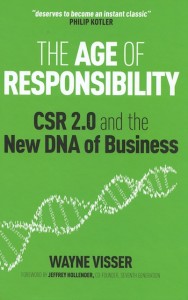Future Trends in CSR:
The Next 10 Years
Article by Wayne Visser
Looking to the future, what is needed – and what is just starting to emerge – is a new approach to CSR, which I call Systemic CSR, or CSR 2.0. This is a purpose-driven, principle-based approach, in which business seeks to identify and tackle the root causes of our present unsustainability and irresponsibility, typically through innovating business models, revolutionizing their processes, products and services and lobbying for progressive national and international policies. I have identified 10 trends:
Trend 1 – In the future, we will see most large, international companies having moved through the first four types or stages of CSR (defensive, charitable, promotional and strategic) and practicing, to varying degrees, transformative CSR, or CSR 2.0.
Trend 2 – In the future, reliance on CSR codes, standards and guidelines like the UN Global Compact, ISO 14001, SA 8000, etc., will be seen as a necessary but insufficient way to practice CSR. Instead, companies will be judged on how innovative they are in using their products and processes to tackle social and environmental problems.
Trend 3 – In the future, self-selecting ‘ethical consumers’ will become less relevant as a force for change. Companies – strongly encouraged by government policies and incentives – will scale up their choice-editing, i.e. ceasing to offer ‘less ethical’ product ranges, thus allowing guilt-free shopping.
Trend 4 – In the future, cross-sector partnerships will be at the heart of all CSR approaches. These will increasingly be defined by business bringing its core competencies and skills (rather than just its financial resources) to the party, as Wal-Mart did with its logistics capability in helping to distribute aid during Hurricane Katrina.
Trend 5 – In the future, companies practicing CSR 2.0 will be expected to comply with global best practice principles, such as those in the UN Global Compact or the Ruggie Human Rights Framework, but simultaneously demonstrate sensitivity to local issues and priorities. An example is mining and metals giant BHP Billiton, which have strong climate change policies globally, as well as malaria prevention programmes in Southern Africa.
Trend 6 – In the future, progressive companies will be required to demonstrate full life cycle management of their products, from cradle-to-cradle. We will see most large companies committing to the goal of zero-waste, carbon-neutral and water-neutral production, with mandated take-back schemes for most products.
Trend 7 – In the future, much like the Generally Accepted Accounting Practices (GAAP), some form of Generally Accepted Sustainability Practices (GASP) will be agreed, including consensus principles, methods, approaches and rules for measuring and disclosing CSR. Furthermore, a set of credible CSR rating agencies will have emerged.
Trend 8 – In the future, many of today’s CSR practices will be mandatory requirements. However, CSR will remain a voluntary practice – an innovation and differentiation frontier – for those companies that are either willing and able, or pushed and prodded through non-governmental means, to go ahead of the legislation to improve quality of life around the world.
Trend 9 – In the future, corporate transparency will take form of publicly available sets of mandatory disclosed social, environmental and governance data – available down to a product life cycle impact level – as well as Web 2.0 collaborative CSR feedback platforms, WikiLeaks type whistleblowing sites and product rating applications (like the GoodGuide iPhone app).
Trend 10 – In the future, CSR will have diversified back into its specialist disciplines and functions, leaving little or no CSR departments behind, yet having more specialists in particular areas (climate, biodiversity, human rights, community involvement, etc.), and more employees with knowledge of how to integrate CSR issues into their functional areas (HR, marketing, finance, etc.)
Collectively, these trends reflect a scenario …
Continue reading
[button size=”small” color=”blue” style=”download” new_window=”false” link=”http://www.waynevisser.com/wp-content/uploads/2012/12/inspiration_csr_trends_wvisser.pdf”]Pdf[/button] Future Trends in CSR (article)
Related pages
[button size=”small” color=”blue” style=”info” new_window=”false” link=”http://www.waynevisser.com/books/the-age-of-responsibility”]Page[/button] The Age of Responsibility (book)
[button size=”small” color=”blue” style=”tick” new_window=”false” link=”http://www.csrinternational.org”]Link[/button] CSR International (website)
Cite this article
Visser, W. (2012) Future Trends in CSR: The Next 10 Years, CSR International Inspiration Series, No. 11.





 If we expect the right to fair treatment, we have a responsibility to respect the rule of law and honour the principle of reciprocity. If we believe in the right to have our basic needs met, we have the responsibility to respond when poverty denies those rights to others.
If we expect the right to fair treatment, we have a responsibility to respect the rule of law and honour the principle of reciprocity. If we believe in the right to have our basic needs met, we have the responsibility to respond when poverty denies those rights to others.